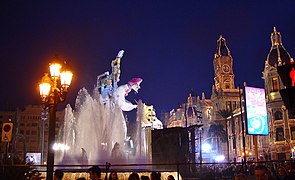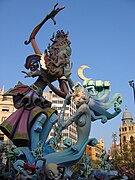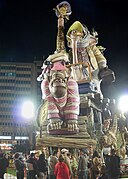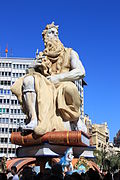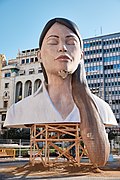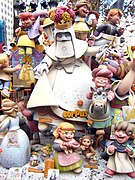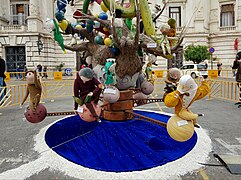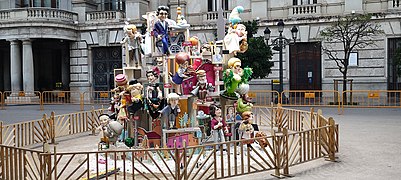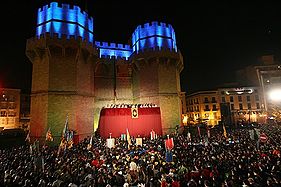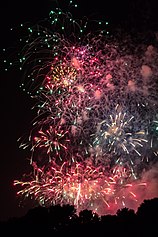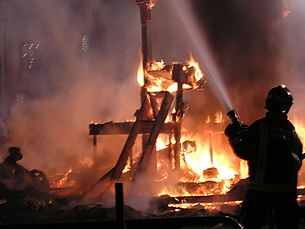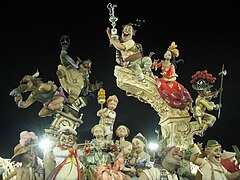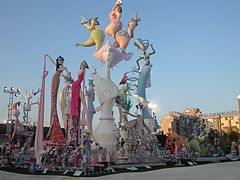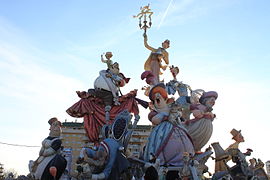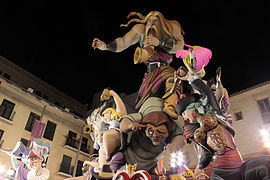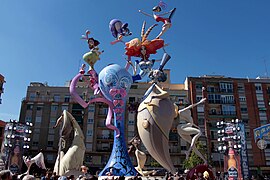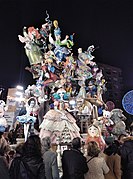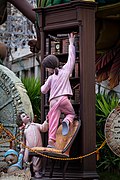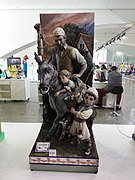Fallas in Valencia
The Fallas de Valencia (Falles in Valencian) are festivities that go from March 14 (plantà infantil) to 19 (cremá) with a tradition rooted in the Spanish city of Valencia and different populations of the Valencian Community. They officially begin on the last Sunday of February with the act of the crida (in Valencian; 'pregón o llamada', in Spanish).
Currently, this festivity has become a very important tourist attraction, since in addition to being classified as a festival of International Tourist Interest, in November 2016 UNESCO inscribed them on its Representative List of the Intangible Cultural Heritage of Humanity. These festivities are also called fiestas josefinas or festes de Sant Josep (in Valencian), since they are celebrated in honor of Saint Joseph, patron saint of carpenters, who was a guild very widespread in the city when they began to be held at the end of the XIX century, and which it retained until today, given the importance of the furniture industry in the region.
Etymology
In medieval Valencian, the word falla (from the Latin fac[u]la, diminutive of fax, 'torcha') was used to name the torches that were placed on top of the watchtowers.
In the Llibre dels Fets, it is mentioned that King Jaime's troops carried fallas (torches) to illuminate both the path and the entrance to the tents. Torches were also used to light a party. Later reference is made to this term to refer to the bonfires and luminaries that were lit on the eve of extraordinary and patron saint festivities.
History
Origin
On the eve of Saint Joseph's Day, bonfires were lit to announce his festivity, receiving this ritual practice the name of "cremà".
The popular version of the origin of the fallas according to the Marquis of Cruïlles, were initiated by the union of carpenters who burned on the eve of the day of their patron Saint Joseph, in a purifying bonfire, the shavings and leftover old junk, making cleaning of the workshops before entering spring. In addition, they burned their "parots” (structures from which the lamps that gave them light hung) since with the end of winter and the arrival of spring, and as the days became longer, they were no longer necessary. According to this theory, popular inventiveness gave these parots a human form. This romantic legend of the origin of the festival contrasts with the documentation preserved in the Carpenters Guild, which does not cite the construction of fallas on its eve, but the religious festival of March 19 itself.
There are other authors who try to find an older origin to the festival, defending that the cult of fire is a ritual of pagan tradition, as occurs with other festivities such as San Antón, the bonfires of San Juan, San Miguel or Christmas in various parts of the Spanish geography, where bonfires are also burned on its eve. According to this theory, the Fallas are an evolution of this archaic ritual that announces the arrival of spring. This origin is "unofficial" nor has it been proven that it is historically so, there is only reference to the tradition of carpenters.
The first documented reference to the Fallas dates back to 1774, but it is not until 74 years later, in 1848, when continuous publications can be found about the Josefina festival.
Suspensions
Throughout its history, the Fallas de Valencia have been completely suspended six times: 1886, 1896, 1937, 1938, 1939 and 2020.
In 2004, official acts were canceled for three days as a result of serious terrorist attacks in Madrid.
In 2020, due to the COVID-19 Pandemic, the festivities were postponed and then cancelled. In 2021, the festivities were postponed and were held, with the corresponding security measures, from 1 to September 5.
1886: protest of the fallas
The first time that there is reference to the fact that the Fallas monuments were not planted was in 1886, when the Fallas (individually) refused to pay the fee of 60 pesetas that had been charged as a fee since 1851 for planting the catafalques on the streets.
At first they paid 5 pesetas, but the rulers didn't like it at all when they got involved in very popular festivals. For this reason, they wanted to put an end to them, forcing them to pay more and more to make them disappear and, indeed, they were less until in 1886 when no commission planted fault, explains the historian, documentalist and member of the Central Fallera Board of Valencia, Javier Mozas. However, from that year there is news that two fallas were planted privately in two interior patios, which no one visited.
1898: Cuban War
The civil governor of Valencia declared a state of war in 1898 due to the war between Spain and the United States in what is known as the Cuban War and it was decided not to celebrate the Fallas two days after it began.
This meant “the first suspension of the Fallas”, although it is known that there were catafalques that were saved and planted the following year, because it has been confirmed that the sketches are the same.
1937, 1938 and 1939: Spanish Civil War
The festivities were also suspended during the years 1937, 1938 and 1939 due to the Spanish civil war. Those of 1936 were held without problem, since the coup d'état took place on July 17.
At the beginning of the war, many Fallas commissions began to allocate the money collected from the Fallas to the Republican cause. At one point, it was decided that no faults would be planted to prevent the crowd they summoned from attracting a bomb or misfortune.
The Civil War ended on April 1, 1939, so that year, for the fifth time in history -the fourth caused by a suspension itself- no Fallas monuments were planted on the streets of Valencia.
2020: COVID-19 Pandemic
On March 10, 2020, the Generalitat Valenciana, after a Health report, decided to suspend and postpone the Fallas festivities and all the acts that comprise it as a result of the coronavirus pandemic as a preventive measure to stop the expansion of the virus. On May 13 they were definitively suspended, since at first it was planned to celebrate them at another time of the year. On January 14, 2021, the regional government decided to postpone the failures of that year, which were held from September 1 to 5, 2021.
Other fallas celebrations
Las fallas are festivals native to the city of Valencia, although over the years they have begun to be celebrated in a large number of municipalities in the Valencian Community, and even outside of it. In this way, the province of Valencia is where the greatest number of Fallas monuments and commissions are concentrated outside the city limits, among which are the Fallas of the towns of Sueca in 1854, Játiva in 1865, Gandía in 1876, Alcira in 1889, Torrente in 1900, Alacuás, Albal, Albalat de la Ribera, Albalat dels Sorells, Alberique, Alborache, Alboraya, Albuixech, Alcácer, La Alcudia, Alcudia de Crespins, Aldaya, Alfafar, Alfara del Patriarca, Alfarp, Algemesí, Alginet, Almácera, Almusafes, Benaguacil, Benetúser, Benicarló, Benicull, Benifayó, Beniparrell, Bétera, Bolbaite, Bonrepós and Mirambell, Buñol, Burjasot, Carcagente, Carlet, Casinos, Catarroja, Chella, Chiva, Cheste, Cuart de Poblet, Cullera, Denia, El Puig, Enguera, Emperor, Faura, Foyos, Genovese, Gilet, Godella, Godelleta, Guadasuar, Jaraco, La Eliana, Liria, Llaurí, Loriguilla, New Crown Place, Llombay, Llosa de Ranes, Manises, Masamagrell, Masalfasar, Masanasa, Meliana, Mislata, Mo ncada, Monserrat, Montroy, Museros, Náquera, Oliva, Onteniente, Paiporta, Paterna, Picaña, Picasent, Poliñá de Júcar, Puebla de Farnals, Puebla de Vallbona, Puerto de Sagunto, Puzol, Ribarroja del Turia, Riola, Rocafort, Real, Sagunto, Rotglá and Corbera, Sedaví, Silla, Sollana, Sueca, Valldigna Taverns, White Taverns, Turís, Utiel, Fenced, Vinalesa, Villanueva de Castellón, Villamarchante, Chirivella or Yátova.
In the provinces of Castellón and Alicante, the Fallas festivities are celebrated in various towns, among which it is worth highlighting the commissions of Benicarló, Almenara, Burriana or Vall de Uxó in Castellón and Denia, Calpe, Elda, Pego and Benidorm in Alicante. Outside the Valencian Community, a falla has been planted every year since 1962 in the Madrid town of Getafe, as well as since 1974 in Villahermosa (Ciudad Real) and since 1982 in the Jaén town of Mancha Real, in this case because it is a town with a large furniture industry. In the same way, in Calviá (Mallorca), the fault "El Toro" since 1994. Also in Ibiza, in San Antoni de Portmany, the Sant Antoni de Portmany Valencian Cultural Association celebrates its Josefinas festivities. To this we must add that in 1989 a fault was planted occasionally in the city of Paris. Outside of Europe, since 1954 the Valencian Regional Union of Mar del Plata celebrates its Fallera Week, which constitutes a kind of unofficial closure of the summer tourist season. In Murcia, since the XIX century, the Burial of the Sardine is celebrated on the Saturday after Holy Week, culminating with the Spring festivals in the city. In it, an allegorical falla of the sardine is planted and burned, which represents the end of the holiday period initiated by Lent.
Also in the 1930s, the fallas became popular in Tarragona, reaching the point of planting six fallas and truncating the tradition during the Spanish civil war.
Party elements
The Fallas Central Board
The Junta Central Fallera is the body that regulates and coordinates the Fallas festival both in the city of Valencia with the commissions of each Falla, as well as with the District Boards. It also coordinates the different Falleras Local Boards in the various towns where this festival is celebrated, such as Alacuás, Alfafar, Aldaya, Algemesí, Alcira, Benidorm, Benetúser, Burriana, Catarroja, Cullera, Sedaví, Massanassa, Paterna, Mislata, Tabernes Blanques....
It is based in the building attached to the museum Fallero, in front of the City of Arts and Sciences, next to the Monteolivete church. The Junta Central Fallera is in charge, for example, of making the election of the Fallera Mayor of Valencia, of choosing the best fallas of all categories, as well as organizing the main events of the festival, such as the Offering of Flowers to the Virgin María de los Desamparados, and many others. It is necessary to highlight its civic and organizational importance in the Valencian Community.
The Fallas artists
The fallero artist (called a artista faller) performs the falla, but there are also fallero artists who do secondary jobs such as making floats and decorations for premises, shops and fairs. These belong to the Artisan Guild of Falleros Artists (Gremi artesà d' Artistes fallers. València).
The fallas commissions
The commissions arose without a regulation that regulated them. But according to Almela i Vives, every fallera Commission included: the owner of the cafeteria located closest to the place where the falla was planted (which became the meeting place for the other components of the commission), the owner of the carpentry from the area (who acted as a technician), the shoemaker from the commission (who provided suggestions), and the owner of the grocery store and colonials (who served as treasurer).
Almost on every street in the city there is a "casal fallero", a meeting place for each of the fallas commissions, which throughout the year look for sources of income to be able to pay for the party and their own monument. In addition, normally each commission also consists of a children's commission, made up exclusively of children, which also plants its own falla. The children's fallas measure a maximum of 3 meters in diameter and are made up of figures with an aesthetic closer to the world of children and generally do not show critical themes.
Although the objective of the commissions is to build the falla for the festival of San José, during the rest of the year in each casal all kinds of festive, cultural and social events are held, which make The Fallas commissions are one of the main axes of associative life and of the social fabric of Valencia and the other municipalities where this festival is celebrated.
The flaw
According to Francisco Almela i Vives, the fallas are "ephemeral catafalques with figures that are raised in the City of Valencia for the feast of Saint Joseph to be burned".
They are usually satirical about current affairs. The fallas usually consist of a central figure or composition several meters high, the largest exceeding 30 meters (exactly the Na Jordana 2001 fault, with 33 meters, was the highest and most voluminous in history) surrounded by numerous figures of cardboard, plasticine, stone, polyurethane (a material that in recent years has been replaced by more modern ones such as expanded polystyrene, which is lighter and more moldable), supported by a wooden frame. They include signs written in Valencian explaining the meaning of each scene, always with a critical and satirical sense.
The Fallas Artists dedicate themselves throughout the year to making the monuments that the different commissions of Valencia and the towns of the city hire, which promotes job creation. The infantile fallas dawn planted on March 15 and the large fallas on March 16, the day the festival officially begins. The act in which the falla is burned is called la cremà (the burning) and it takes place on March 19, the day of Saint Joseph (Sant Josep), the patron saint of the fallas festivities.
As a complement to the signs, some commissions make the "llibret de la satira", in which the content of the falla is explained through satirical verses. This genre began in the XIX century with the Swedish author Bernat i Baldoví, and experienced its peak in the 50s and 60 of the XX century, thanks to authors such as Emili Panach or José Bea Izquierdo. And this tradition has become so important that it even has its own category in the awards section. Each year, different awards are given to the books according to categories and criteria, in what refers to the design, information it contains, originality, etc. So the "llibret" It is one more element of the world of fallas, in which many people, as in the monument, put their efforts to create the best product and, if possible, collect one of the prizes with all the commission.
- Valencia City Hall
Children's failure
Each Fallera commission plants a smaller version next to its Falla, which belongs to the child members of the commission.
- Municipal children ' s deaths in Valencia
Fireworks
One of the main elements of the Fallas festivals are the fireworks, since since gunpowder and fireworks arrived with the Muslims, they have always been linked to the festivities of the Valencian people.
Traditional clothing
The traditional Valencian woman's costume, the misnamed fallera costume, because in fact it was already dressed before the fallas appeared as a party, has a long tradition in history. It appeared in the XVI century and began as a work outfit for Valencian farm women, but as time went by it was transformed, and led to more elegant clothing that was worn on special occasions. In short, the dress worn by the falleras is the party dress worn by the Valencian women centuries ago. Among its variants we find the suit of the XVIII century, more Frenchified; those of coteta, closer to those of huertana; and the one that emerged in the 19th century, called farolet for its lantern-shaped sleeves. In her hair, the woman can wear a bow or three. On the back of her head is a larger one, while on her temple are two smaller ones, the "bundles". The bows are caught with passing needles and decorated with the combs, the pinta for the back bun and the rascamonyos for the buns, inspired by the costumes of the Lady of Elche from more than 2500 years ago.
Traditional male clothing can be of various types. One is the saragüell costume, which appears under the name sarawil in Andalusian Muslim texts from the X. This garment consists of wide pants placed directly on the body and on which other garments can be superimposed or not. The fabric of this garment is the canvas for work days, and on holidays it is covered with a second woolen or silk breeches, known as bold. Another of the traditional male clothing is the torrentí suit, which is characterized by having pants that are tighter to the leg and a chopetí, a kind of vest and/or jacket. On his head, the man usually wears a mocador (handkerchief), a cap or a skullcap, the latter made of crochet, which are complemented with different caps and hats, such as the rodina, the cossiol or the montera.
- Dress accepted by JCF
- The failure must dress:
- Costume torrentí.
- Costume saragüell.
- The costume consists of long striped trousers, silk or yarn shirt, vest and girdle, with black shoes and socks or labrador alpargatas with embroidered socks.
- The use of ties, flowers and ties of any kind is expressly prohibited.
- The failure should dress:
- The gala costume of the Valencian farmer, with three wets, must observe the greatest decorum in his garment.
- Costume of the centuryXVIIIwith one or three wets.
- I brought an orphan with a bow.
- The use of any piece of clothing or ornaments other than the traditional and typical of the suit is not permitted. Only the use of labrator alpargates is allowed if they are externally lined with the same fabric of the corresponding fallout suit.
For both the fallero and the fallera, the smock will never be considered traditional Valencian clothing and can only be used in strictly private acts of each falla, when so decided by the Commission itself.
This year 2014, the clothing designer Amparo Fabra has been nominated for the VIII edition of the National Crafts Awards granted by the Ministry of Industry, Energy and Tourism through Fundesarte (Spanish Foundation for the Innovation of Crafts).
Music
Music is intrinsically linked to fallas, as it is such an important element of the party. The Fallas commissions hire more than 300 music bands for the party to accompany them to any of the Fallas acts. Traditionally, the music that accompanies the party is the traditional and popular pasodobles, such as "Paquito el chocolatero", "Amparito Roca", "Valencia" and "El fallero", although more modern and current songs have also been introduced. At these festivities not only bands are heard but there are also groups of traditional Valencian music, made up of dulzainas and tamboriles. Music is also important at night, since the typical festivals are held with orchestras and "discomóviles", which dot all the neighborhoods of the city, and are open to anyone who wants to enjoy them until midnight. sunrise.
Failing Acts
Despite the many and varied events that take place throughout the city, there are some that are permanent, mainly those organized by the Junta Central Fallera, although there are also many that are carried out by the commissions themselves. falleras:
La Crida
- The Crida, the Spanish pregon, is celebrated on the last Sunday of the month of February and is the act in which the main Fallera of the city, gathers in the doors of the same, the Serranos Towers, all the failed commissions and makes a call, to the initiation of the celebrations, all the Valencians and all the visitors. In this act the mayor or mayor of Valencia gives the keys of the city to the eldest failure and give for the beginning the faults.
L'exposició del Ninot (The Ninot Exhibition)
It is a fallero act with many years of roots. In 1973, the mayor of Valencia, Vicente López Rosat, accompanied by the major fallera, Encarnación Folgado, attended the Ninot Exhibition, which was then held at the Lonja.
There are about 800 ninots (dolls, in Spanish) that are presented in this Fallas museum, open to the public for several days in the City of Arts and Sciences. In this, the ninots are presented with the illusion of being able to be pardoned and free from burning, only the best will be saved, and they will be called "Ninot pardon", a tradition that dates back to 1934. The result of the verdict depends on a popular vote.
- After exposing the most precious ninot of each deceased commission, the same failers go to the Ninot Exhibition to collect it (the children's on the evening of 14 March and the elderly on the afternoon of 15 March), after having suffered a testimony from the popular jury. The way to it is usually in group, with music and party on the street. Encouraging the city with multiple impetus and praising the oldest and infantile failure of each fault.
- The return to the fault is done with the ninot at costs or with a vehicle manufactured by them. The wealthiest maritals usually present a more voluminous ninot and are usually able to bring it back.
Ninot ride
The Ninot Cavalcade or Cavalcada del Ninot (in Valencian) takes place on a weekend close to the start of the Fallas week itself. In it, different falla commissions expose, in their cavalcade, a social, political or sports issue, normally of a local or regional nature. The comparsas, figures and floats of each commission satirize or criticize their theme, as if it were an itinerant fault and with "humanized" ninots.
After parading through the center of the city, a jury appointed for this purpose rewards the best fallera commission with different prizes such as the best figure, the best final composition or the best troupe.
The children also had their own Children's Ninot Cavalcade, which followed the same rules of performance as the adults, but since 2012 the two cavalcades have been unified into a single one.
Kingdom Ride
The Kingdom Cavalcade or Cavalcada del Regne (in Valencian), currently known as the International Folkloric Cavalcade, was introduced in 1967 in the Fallas calendar. It consists of a long parade in route and duration that will summarize all the folklore of the three Valencian provinces, Alicante, Castellón and Valencia. One more act to bring one of the most closely lived festivals even closer to the street.
Until 2012, this parade was included in the festive calendar of the fallas week. It used to be the Saturday before March 15 when it was celebrated and included other country regions. This parade stopped being held in 2012.
The mascleta
This event takes place every day at 2:00 p.m., from March 1 to the 19th. The name Mascletá comes from a type of firecracker, the masclet. It is one of the acts most valued by the Valencians, although it is also an act that visitors understand less, since to understand them it is necessary to be close to the place where the pyrotechnic products explode, since it is not a matter of seeing, but of feeling and hear, since they produce sensations similar to listening to a concert, getting the noise to envelop, and all in a matter of a few minutes (6-7) and reaching over 120 decibels.
Basically they are made up of terrestrial material and an aerial beginning and end. However, these compositions vary according to the pyrotechnic. The firecrackers are joined by wicks that are wrapped in paper so that they go faster. Depending on the variation of the wicks, the crossings of several rows, as well as the distance of the firecrackers, manage to give greater or lesser firing speed, which is usually maximum speed at the end of it, obtaining the earthquake end. Different sound and sensation effects are also achieved by having them explode on the ground or tied to the ropes that hold the wicks.
Currently the mascletaes that go off in the Plaza del Ayuntamiento in Valencia, which has an approximate budget between 6,000 and 9,000 euros, however some pyrotechnics do their part to satisfy the public. The fireworks that attract the most public are V. Caballer and R. Caballer
From March 1 to March 19, it is fired daily at 2:00 p.m. A mascletà in the Plaza del Ayuntamiento de Valencia, presided over by the Falleras Mayores and municipal authorities as well as numerous guests who gather on the well-known balcony of the Town Hall.
The Plant
- The 14th and 15th of March at night are the days of the plantà, the act of erecting the failed monuments, best known by the generic name of faults. On the 15th in the morning, the monuments of the children's category are made and between the 15th and early 16th the large monuments, always having to be planted at 08:00 in the morning of the 16th day, when the jury will be presented to qualify them.
Traditionally this act was carried out in a single day; This fact increased the competitiveness of the commissions as well as heightened the emotion, since the monument, if it was not completely finished, would be disqualified. Currently, in many towns the date of the plantà varies, being from the 14th to the 16th, even on other dates, since their fallas weeks do not coincide with the official ones in Valencia.
The way to raise the main part of the monument was done by means of a colla of people belonging to the fault. Which was erected at once, called plantà al tombe. Currently, some commissions wanting to distance themselves a bit from the competitiveness are trying to return to their origins by carrying out the plantà in its old modality.
Since the 90s and due to the size of the monuments in the special section, their planting can begin on March 10.
La despertà(La petardà)
- Every day with the despertà, the failers wake up the rest of neighbors throwing down some known firecrackers "tro de bac"which explode when they hit the ground, or masclets (small-impact cheeks). The despertàs they are criticized by the neighbors because in Valencia it is only festive on March 19 and these petardos cause discomfort to the non-fair neighbors.
The prize collection
- On this day all the failed commissions come to the place where they have been summoned to receive the award given to them. These hang the award given in the enclosure of their fault so that the rest of people who are not failing can see them.
L'Ofrena (The Offering)
The offering to the Virgen de los Desamparados, or, affectionately known as "La Geperudeta" (La Jorobadita, in Spanish), patron saint of the city of Valencia and the Valencian Community. The offering is made throughout the afternoon and early evening on March 17 and 18. Initially, it was held only on the 18th, but due to the large number of fallas commissions, it was extended to two days, bringing it forward to the previous day. In it, each fallera offers a bouquet of flowers with which a spectacular tapestry of flowers is made as a cloak that covers the body of the Virgin, whose wooden structure allows the bouquets to be intertwined to form impressive designs. This, added to the 14 meter height of the Virgin, give the offering a great showiness. The mantle is shed 3-4 days after March 19.
After having presided over the flower offering, the greatest fallera of Valencia will close the event, being the last to parade before the Virgin.
To observe the "Offering" as we know it now, we must go back to the middle of the century, it is said that it was a Fallera Mayor of the Journalist Azzati Falla, who decided to bring a bouquet to the Virgin, the following year the commission decided to do it again and in later years some A few Fallas commissions, of their own free will, entered the Basilica to offer flowers to the image of the Patron Saint[citation required]. Year after year, more commissions and more falleros and falleras were added to the act that paraded before the Virgin, reaching today a figure of more than 100,000 people, spread over two days, for more than 20 hours of offerings in total. It is not surprising that this act is one of the most anticipated and its result (the large cloak of the Virgin made in flower) one of the most visited during and after the festivities. Due to the fact that the Fallas are relatively close to Easter, the Archbishop of Valencia expressed his complaint that they were days with too many parties for the dates that were approaching. Given this fact, they decided to hold a religious ceremony to add a touch of seriousness and calm to the festivities.
Castells de focs artificials (Fireworks Castles)
During the Fallas festivities, from March 15 to 19, the City Council programs a Fireworks Display every night, which goes off, depending on the day, between 00:00 and 1:30 in the Alameda area next to the old bed of the Turia river.
The most important and spectacular of the castles is the one known as "La Nit del Foc" (Night of Fire) which is fired on the night of March 18-19, and for more than 20 minutes, thousands of kilograms of gunpowder (2450 kg, year 2015) light up the sky of Valencia, with more than a million people congregating to witness it.
The Fire Ride
The Fire Parade (Cavalcada del Foc officially and in Valencian) is a parade that announces the arrival of fire that will burn the Fallas. In the past, it was the act in which, after removing the ninots from the falla, they were taken on horseback to the Museu Faller (Museo Fallero). Recently established (2005), it is a proposal of the Foreign Promotion delegation of the Central Fallera Board and the Association of Falleros Studies (Associació d'Estudis Fallers) (ADEF) to recover the tradition Valencian festival, which dates from the thirties of the XX century, and which rescues the custom that troupes of devils and floats of the god Pluto ignite the Fallas. For this reason, it takes place on March 19 in the afternoon, starting at 7:00 p.m., along Calle Colón and up to Porta de la Mar, as a prelude to the Cremà de las Fallas. colles de dimonis from the entire Valencian Community participate in it, constituting an authentic and spectacular Fire Run in the very historic center of Valencia.
La Nit de la Cremà (The Night of the Cremà)
The cremà is the closing act of the festivities. It consists of the burning of the Fallas monuments planted in the streets of Valencia and in its towns on March 19. The act is preceded by a fireworks display, lit by the Fallera Mayor and the president of the Commission. First, at around 10:00 p.m., the children's monument is burned, except for the first-prize-winning falla in the special section, which is burned at 10:30 p.m. At 11:00 p.m. the municipal children's monument is burned. Later at 00:00 at night the large monuments are burned and at 00:30 the first prize in the Special Section of this category is burned. Finally, at one o'clock in the morning, the Fallas monument in the Plaza del Ayuntamiento is burned, which is out of competition, since it is the official one of the Town Hall.
Awards
The Fallas are classified by section, being the Special section the most important of all, since it brings together the Fallas commissions that plant the Fallas with the largest budget in the city, and that compete for the award for the best falla, which is why it is usually considered the first division in the world of fallas. In 2011 there were a total of 13 fallas in this Special Section, while the number of monuments planted in the City is almost 400. This section was created for the first time in 1942 and in that year only three commissions took part in the category, those of Barcas, Reina-Paz and Plaza del Mercado and today of those three only the Plaza del Mercado falla belongs to this section. Currently, the falla that has won the First Prize the greatest number of times is the Plaza del Pilar commission (16). The rest of the Valencia commissions compete in categories lower than this, ranging from Section First A, First B to the seventh C, the lowest of all sections. Currently the Fallas of the Special section are:
- Na Jordana
- Jerusalem-Matematic Convent Marzal
- Admiral Cadarso-Conde Altea
- Exhibition-Micer Mascó
- Cuba-Literato Azorín
- The Pilar
- Sueca-Literato Azorín
- Kingdom of Valencia
- L’antiga de Campanar
All this in terms of the large monuments, since in turn, the children's monuments fight for the prize for the best children's falla. These monuments are also classified in different categories or sections, also highlighting in this case the Special section. One of the most important activities is to take a tour of the Special Section Fallas. Every year the town hall provides buses and the means to visit them as well as possible.
Failure Awards
Each of the sections in which all the monuments that are planted in the city of Valencia are divided opt to achieve the first prize of the section in which they compete. But apart from this prize for the entire Falla, other prizes are also awarded, such as the prize for ingenuity and grace, which does not have to coincide with the prize for the best monument in the section.
The Fallas (for children and adults) that the Valencia City Council plants in the Plaza del Ayuntamiento are the only ones that do not compete for any award, since they participate out of competition in the Fallas festival and, for decisive reasons in the commission, Arrancapins failure, either.
- First special section awards
Ninot pardoned
Every year two ninots (child and adult) are saved from the flames by popular vote.
- Ninot pardontat
Lighting Awards
Everything has a beginning. First it is an idea, which becomes an illusion, later a plan and finally comes true.
On any given day in the early 1970s, four people met for lunch at the Monte Picayo casino. Their names:
- -D.Eugenio Gares Cardona (Office of Administration of Justice)
- -D.Vicente Muñoz Quiles (Radiophonic Auditor)
- -D.José Carrilero Brunet (Department Merchandise of G.T.E. Sylvania)
- -D.Francisco Castro Sancha (Delegado zona lifted de G.T.E Sylvania)
What began as an informal meeting, ended up being the beginning of what is currently known as "awards for the best illuminated faults". Eugenio Gares, in addition to the position he held in the justice ministry, was also the president of the Cuba-Puerto Rico ruling. Someone who, like Vicente Muñoz, was in love with the Fallas festival and Valencia. Both were the idea and the illusion. During the meal, Eugenio asked Francisco Castro a simple question: -Paco, do you know what Valencia is? -The aforementioned shook his head- well, don't worry, I'll tell you. Valencia is the land of flowers, of THE LIGHT, and of love. Currently there are awards for the "best decorated streets", but the fallas should reflect the spirit of Valencia, and be full of light. Well lit... didn't you just tell me that you are the representative of a multinational lighting company?
And so, during the after-dinner meal, Francisco Castro became the plan. A few months later, after much study and planning, he sent a dossier, via fax, about the Fallas festival, to his company headquarters, located in Connecticut (USA), outlining the idea of creating prizes to extol the festival., and financially reward those faults that best illuminate its streets and squares. The answer was not long in coming… they loved the idea.
1975 was the first year in which the awards were called, called at that time: "G.T.E Sylvania Trophy, best illuminated streets for Fallas festivals." The call was published in the newspapers, with the offer of cash prizes.
Fourteen commissions competed for this trophy in the first contest. Only three won:
- 1.o Premio: Comisión Calle Cuba-Puerto Rico
- 2.o Prize: Plaza Na Jordana Commission
- 3.o Prize: Commission Calle Cádiz-Denia
The first jury was made up of the following members:
- - Jury President: D. Manuel Vidal (Director of “La Voz de Levante”)
- -1.o vocal: D. Vicente Muñoz Quiles (Periodista y locutor)
- -2.o vocal: D. José Martí Mardi (Gerente de Gabarró, S.A.)
- -3.o vocal: D. Fernando Miquel Boronat (Vda. de D. Miquel)
- -4.o vocal: D. Enrique Roca Xenia (Vda. de Roca Ruiz, S.A.)
- -5.o vocal: D. Francisco Castro Sancha (Gerente de G.T.E. Sylvania)
The awards ceremony took place on March 15, 1975 at the Alhambra hotel in Valencia, at 1:00 p.m. They attended the event, as guests of honor:
- D.Miguel Ramón Izquierdo (Alcalde de Valencia)
- D. Ramón Pascual Lainosa (President of JCF)
- D.Jesus Maroto González (Vice-Chairman of JCF)
- Miss. Macarena Cañamas Gadea (Fallera Mayor of Valencia 1975), together with his court of honor.
Some Fallas participate in the Lighting Contest currently organized by the Junta Central Fallera. The practice of lighting the streets during fallas is relatively recent and is not considered traditional. Although in 2010, the Cuba-Puerto Rico ruling commission celebrated 50 years of decorating its street with thousands of light bulbs. The streets of Valencia have always been illuminated to brighten the city even more these days, but the competitiveness of the commissions has generated this contest.
In recent years, the prize for the best lighting has gained importance, in which the streets of the Fallas demarcation of each house are illuminated with multicolored lights. There are fallas that attract a large influx of public thanks to their lighting, we must highlight the falla of Sueca-Literato Azorin, which is the winner of the lighting award for the last 15 years, and every year has a large influx of public to see its impressive lights.
Other awards
- Award for the best street decoration.
- Award for the best llibret fault.
- Award for the best Ninot Adaptat.
Criticism and rejection
Las Fallas have received some criticism from some sectors of the population, both in the Valencian Community itself and outside of it. Without a doubt, the most controversial fallas traditions are those related to fireworks, essential in this festival: the "despertà" receives criticism, since its opponents maintain that the residents who are not part of the party should not be bothered; the "mascletà" it creates a noise level that can reach 120 decibels, and critics argue that such noise levels cannot be tolerated in the center of a city as crowded as Valencia is, since it disturbs the surrounding environment in an extraordinary way, although it only lasts 10 minutes a day during the 19 days in which they are fired; along with these failing acts, the sale and use of pyrotechnic devices, known as "firecrackers", which generate discomfort among pedestrians and neighbors as well as being a risky activity, since every year burns and injuries occur among users of these products.
Residents also complain that from March 1 to March 20, more than 400 streets and main roads are closed to traffic, both those near tents and faults, as well as the set of roads of Ciutat Vella, causing a "circulatory chaos" during all the festivities. Public spending on the Fallas is also highly criticized, since for critics public spending, both direct and indirect, greatly exceeds any income that tourism can generate. In addition to this, the pollution caused by the festivities, both acoustic and atmospheric, as well as the accumulation of waste in the streets of the city, is also criticized.
Contenido relacionado
Baroque Spanish Literature
Gypsy town
Yuri (gender)

